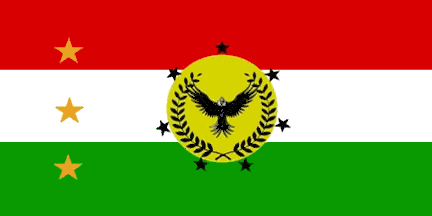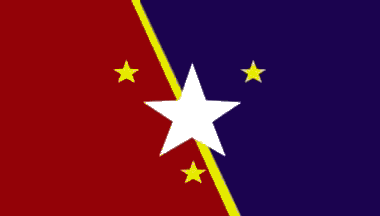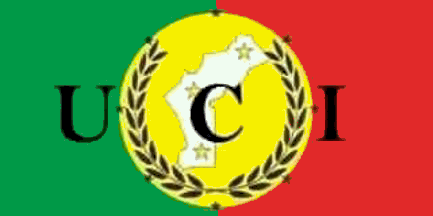
This page is part of © FOTW Flags Of The World website
Flags of other separatist movements in Cabinda (Angola)
Last modified: 2022-10-22 by bruce berry
Keywords: cabinda | enclave | angola |
Links: FOTW homepage |
search |
disclaimer and copyright |
write us |
mirrors
- Cabinda - historical and political background
- Frente Unida para Liberta��o de Cabinda (FULC)
- Movimento Independista de Cabinda (MIC)
- Movimento Liberta��o de Cabinda (MLC)
- Uni�o dos Cabindeses para Independ�ncia (UCI)
- Frente de Libertação do Enclave de Cabinda (FLEC)
- Frente de Libertação do Estado de Cabinda (FLEC)
- FLEC-Renovada
- Angola
- Angola : national index
- Cabinda Province (current administrative status)
- "Independent Cabinda" / "Republic of Cabinda"
History of Cabinda
Unlike most other African territories colonized by European countries, Cabinda came into Portuguese possession peacefully, because it was a weak kingdom surrounded by stronger ones and its king asked for Portuguese protection (this is said by the people of Cabinda themselves and not only by Portuguese historians). Cabinda remained a territory under protection until the middle of the 20th century when the Portuguese dictator Ant�nio de Oliveira Salazar decided to unite Cabinda and Angola to make one colony (he called it first 'Ultramarine' Territories, and then 'Ultramarine' provinces, like today's French policy). So, apart from oil-greed, Cabinda's fight for self-determination has some historical basis. As far as flags are concerned, I don't think there is (or was) one. Salazar's policy was 'one nation in Europe and outside Europe', so the flag used was the Portuguese national flag.Jorge Candeias, 11 August 1997
Portugal first claimed sovereignty over Cabinda in February 1885 through the
Treaty of Simbulambuco which gave Cabinda the status of a Portuguese protectorate.
Following the confirmation of the borders of Angola in the mid-1920s, Cabinda
was treated as part of Portuguese West Africa (Angola). In 1974-75, when Portugal
gave independence to its African colonies, it was done in a colony by colony
basis. According to the Treaty of Alvor between Portugal and the liberation
movements in Angola, Cabinda was re-confirmed as being an integral part of
Angola. There where never
plans for a separate independence process for the enclave although the Treaty
was rejected by the Front for the Liberation of the
Enclave of Cabinda (FLEC) and other local political movements which
advocated independence for the territory.
Jorge Candeias, 04 March 1999
The Fischer Weltalmanach (1976) has a virtual independent Cabinda;
Cabinda became important in the 1960's when the Golf Oil Co. discovered
oil. The independence movements of Angola saw Cabinda always as an integral
part of Angola, while Zaire and
Congo (Brazzaville) assisted separatist
movements; FLEC had its main seat in Kinshasa till 1975. In July 1975
a provisional revolutionary government (president: Luis Ranque Franque,
president of FLEC, prime minister: Francisco Xavier Lubota) was proclaimed,
which wanted elections, and independence on 11 Nov 1975, together with
Angola.
The Fischer Weltalmanach (1978) mentions a new FLEC-provisional
government under Henrique Thiago in Sanda-Massala.
After that it stayed Angolan, as far as I know.
Jarig Bakker, 04 March 1999
[Cabinda is now a province of Angola, the symbols of which can be seen here.]
Frente Unida para Liberta��o de Cabinda (FULC)
 image by Valentine Poposki, 15 Sept 2020
image by Valentine Poposki, 15 Sept 2020
Frente Unida para Liberta��o de Cabinda (FULC)
or the United Front for the Liberation of Cabinda, is one of the newer
pro-independence parties in Cabinda. A statement on
its objectives can be read
here.
Valentine Poposki, 15 Sept 2020
Movimento Independista de Cabinda (MIC)
 image by Valentine Poposki, 15 Sept 2020
image by Valentine Poposki, 15 Sept 2020
 image by Valentine Poposki, 15 Sept 2020
image by Valentine Poposki, 15 Sept 2020
Movimento Independista de Cabinda (MIC)
or Movement for the Independence of Cabinda, has had two flags. The second
has been in use since 2019 and comprises three horizontal stripes of red, white
and green with the MIC's emblem in the centre surrounded by 7 black five pointed
stars. There are also three yellow five pointed stars in a vertical line
near the hoist.
Valentine Poposki, 15 Sept 2020
Movimento Liberta��o de Cabinda (MLC)
 image by Valentine Poposki, 15 Sept 2020
image by Valentine Poposki, 15 Sept 2020
Movimento Liberta��o de Cabinda (MLC)
or Movement for the Liberation of Cabinda uses a flag divided diagonally deep
red and blue, separated by a yellow fimbriation. In the centre is a large
white five pointed star, with two smaller yellow five pointed stars above it and
a single yellow five pointed star below.
Valentine Poposki, 15 Sept 2020
Uni�o dos Cabindeses para Independ�ncia (UCI)
 image
by Valentine Poposki, 15 Sept 2020
image
by Valentine Poposki, 15 Sept 2020
The Uni�o dos Cabindeses para Independ�ncia (UCI) or Union of Cabindese for Independence uses a flag which is the same as initial flag used by the Movement for the Independence of Cabinda but defaced with large black letters of its acronym, UCI.
Valentine Poposki, 15 Sept 2020